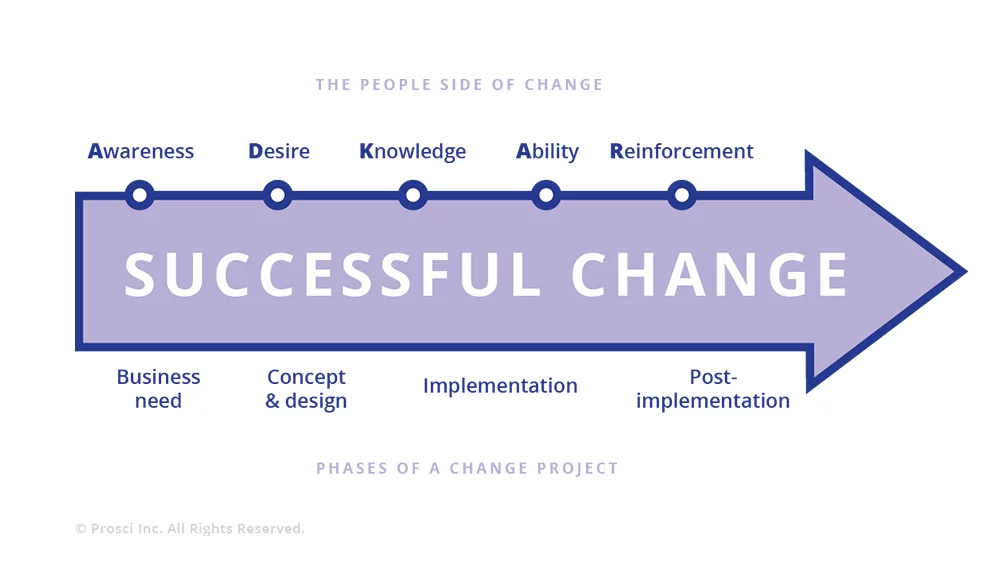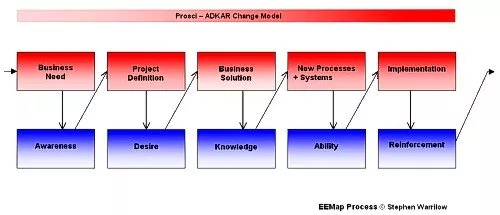
In the world of change management, there are a lot of different models and theories to get to learn.
There’s Kotter’s 8 step process, Lewin’s block of ice model… There are countless systems and methodologies designed to facilitate digital change.
And I guess now you’ve heard of ADKAR change management — I mean, that’s why you’re here.
So I’ll give you the 411 on ADKAR change management. We’ll look at the 7 ways it can be used to ease organizational change. And you can decide for yourself whether it’s right for you.
What is ADKAR change management?
“ADKAR is a research-based, individual change model that represents the five milestones an individual must achieve in order to change successfully.” Prosci
The ADKAR model was created by Prosci founder, Jeff Hiatt. Essentially, it is an acronym that spells out the five stages of change.
Awareness (of the need for change)
Desire (to support the change)
Knowledge (of how to change)
Ability (to show new skills and behaviors)
Reinforcement (to make the change stick)
Unpacking these five stages of change, we can start to see how ADKAR change management works.
Awareness
This is awareness of the business reasons for change. Awareness is essential to move to the next ADKAR stage. A comprehensive communications plan is an important part of the creating awareness process.
Desire
Individuals must develop a desire to engage and participate in the change. This is the goal of sponsorship and resistance management.
Knowledge
It’s important that individuals know how to change. Knowledge is what we hope to achieve through training and coaching.
Ability
This is the ability to realize or implement the change at the required performance level. This step is usually achieved through extra coaching, practice, and time.
Reinforcement
An important part in any change management model, reinforcement ensures change sticks. This is the goal or outcome of measurement, corrective action, and celebrating success.
Those are the five “people” stages of change. Prosci also identifies the “business” dimension of change. Both must happen concurrently in order for change to be effective.
Source: Prosci
How can ADKAR be used in organizational change?
“ADKAR creates a powerful internal language for change and gives leaders a framework for helping people embrace and adopt changes.” Prosci
Change happens at an individual level. Individual staff members must change their behaviors for change to happen at an organizational level.
So, to make change happen within businesses and communities, we must first understand how to change the individual.
This can be daunting and it’s difficult to know where to start. That’s why having a system or model like ADKAR to follow can be extremely helpful.
The ADKAR change management model allows you to focus on what drives individual change. These activities then lead on to achieving organizational results.
The great thing about ADKAR change management is that it provides clear goals for your change management activitieschange management activities. Step 1 is to achieve awareness. Step 2 is to achieve desire. Step 3 is to provide the knowledge. And so on.
It also provides a language and framework in which to discuss change for employees, managers, and senior leaders.
There are 7 ways identified by Prosci in which ADKAR can be helpful.
Source: Prosci
Notice sixth and seventh points: empowering managers and equipping senior leaders.
One of the greatest barriers to successful change management is effective leadership. ADKAR provides a clear structure and direction for leaders.
This is especially valuable to senior management, who must understand the active role they need to play in the change process.
“They understood that their role in successful change is more than approving the budget and sitting at [Steering Committee] meetings.”
Summary
The ADKAR change management model provides a useful framework for managing change. Both in individuals and organizations.
Stephen Warrilow analyzed the ADKAR model and concluded that it is “an effective management checklist.”
In fact, most people agree that the ADKAR model is easy to use. It breaks down the change process into its fundamental elements. So it is simple to understand and apply.
You don’t have to be a change manager to use the ADKAR model, though of course many change professionals do. It’s also used by individuals the world over to make changes in their personal lives.
The ADKAR model combines the “people” and “business” dimensions of change. This leads to a comprehensive workflow for change management. They are amalgamated into a seamless workflow in the image below.
Source: https://www.strategies-for-managing-change.com/adkar.html
This will certainly help to ensure the success of your change management initiatives. But the ADKAR model is not without its weaknesses.
Make sure you analyze your business culture thoroughly to determine whether this model will work. Research other leading change management theories. An amalgamation of several, or an adaptation of one, may be the ideal framework for your business.
WalkMe Team
WalkMe spearheaded the Digital Adoption Platform (DAP) for associations to use the maximum capacity of their advanced resources. Utilizing man-made consciousness, AI, and context-oriented direction, WalkMe adds a powerful UI layer to raise the computerized proficiency, everything being equal.






